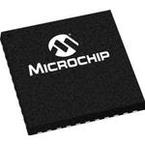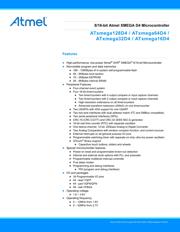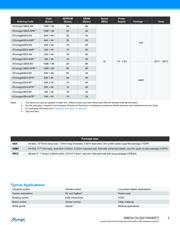Datasheet 搜索 > 微控制器 > Microchip(微芯) > ATXMEGA32D4-MHR 数据手册 > ATXMEGA32D4-MHR 用户编程技术手册 6/328 页

 器件3D模型
器件3D模型¥ 25.382
ATXMEGA32D4-MHR 用户编程技术手册 - Microchip(微芯)
制造商:
Microchip(微芯)
分类:
微控制器
封装:
VQFN-44
描述:
AVR 32MHz 闪存:16K@x16bit RAM:4KB
Pictures:
3D模型
符号图
焊盘图
引脚图
产品图
页面导航:
引脚图在P4P32P49P51P310P313P321Hot
典型应用电路图在P3
原理图在P4P7P9P49P321
封装尺寸在P61P62P63
型号编码规则在P2P3P12P320
封装信息在P3P61
功能描述在P49
技术参数、封装参数在P64P83P102P123
应用领域在P3P12P13P328
电气规格在P14P64P319P320P321
导航目录
ATXMEGA32D4-MHR数据手册
Page:
of 328 Go
若手册格式错乱,请下载阅览PDF原文件

6
XMEGA D4 [DATASHEET]
Atmel-8135S-AVR-ATxmega16D4-32D4-64D4-128D4-Datasheet–09/2016
3. Overview
The Atmel AVR XMEGA is a family of low power, high performance, and peripheral rich 8/16-bit microcontrollers based
on the AVR enhanced RISC architecture. By executing instructions in a single clock cycle, the AVR XMEGA device
achieves throughputs CPU approaching one million instructions per second (MIPS) per megahertz, allowing the system
designer to optimize power consumption versus processing speed.
The AVR CPU combines a rich instruction set with 32 general purpose working registers. All 32 registers are directly
connected to the arithmetic logic unit (ALU), allowing two independent registers to be accessed in a single instruction,
executed in one clock cycle. The resulting architecture is more code efficient while achieving throughputs many times
faster than conventional single-accumulator or CISC based microcontrollers.
The AVR XMEGA D4 devices provide the following features: in-system programmable flash with read-while-write
capabilities; internal EEPROM and SRAM; four-channel event system and programmable multilevel interrupt controller,
34 general purpose I/O lines, 16-bit real-time counter (RTC); four flexible, 16-bit timer/counters with compare and PWM
channels; two USARTs; two two-wire serial interfaces (TWIs); two serial peripheral interfaces (SPIs); one twelve-
channel, 12-bit ADC with optional differential input with programmable gain; two analog comparators (ACs) with window
mode; programmable watchdog timer with separate internal oscillator; accurate internal oscillators with PLL and
prescaler; and programmable brown-out detection.
The program and debug interface (PDI), a fast, two-pin interface for programming and debugging, is available.
The XMEGA D4 devices have five software selectable power saving modes. The idle mode stops the CPU while allowing
the SRAM, event system, interrupt controller, and all peripherals to continue functioning. The power-down mode saves
the SRAM and register contents, but stops the oscillators, disabling all other functions until the next TWI, or pin-change
interrupt, or reset. In power-save mode, the asynchronous real-time counter continues to run, allowing the application to
maintain a timer base while the rest of the device is sleeping. In standby mode, the external crystal oscillator keeps
running while the rest of the device is sleeping. This allows very fast startup from the external crystal, combined with low
power consumption. In extended standby mode, both the main oscillator and the asynchronous timer continue to run. To
further reduce power consumption, the peripheral clock to each individual peripheral can optionally be stopped in active
mode and idle sleep mode.
Atmel offers a free QTouch library for embedding capacitive touch buttons, sliders and wheels functionality into AVR
microcontrollers.
The devices are manufactured using Atmel high-density, nonvolatile memory technology. The program flash memory can
be reprogrammed in-system through the PDI interface. A boot loader running in the device can use any interface to
download the application program to the flash memory. The boot loader software in the boot flash section will continue to
run while the application flash section is updated, providing true read-while-write operation. By combining an 8/16-bit
RISC CPU with in-system, self-programmable flash, the AVR XMEGA is a powerful microcontroller family that provides a
highly flexible and cost effective solution for many embedded applications.
All Atmel AVR XMEGA devices are supported with a full suite of program and system development tools, including C
compilers, macro assemblers, program debugger/simulators, programmers, and evaluation kits.
器件 Datasheet 文档搜索
AiEMA 数据库涵盖高达 72,405,303 个元件的数据手册,每天更新 5,000 多个 PDF 文件






